Twelve and a half centuries ago, the second Abbasid caliph, Abu Jafar al-Mansur, stood at the fertile, marshy edge of the Tigris River’s west bank—at a point where the river almost merges with the Euphrates—and declared it the spot for his new capital. Though its official name was Madinat al-Salam (City of Peace), it came to be known as Baghdad, after the nearby fishing village that was displaced by al-Mansur’s vision and ambition.
“Al-Mansur summoned … engineers, architects and experts,” according to one medieval chronicler, to help him design and build his magnificent city, the foundations of which were laid at a time chosen by the court astrologer.
It fell to one of al-Mansur’s successors, the poet and scholar al-Ma’mun, to outdo him by establishing “his famous Bayt al-Hikmah (House of Wisdom), a combination library, academy and translation bureau,” in the words of historian Philip K. Hitti. This legendary institution attracted some of the greatest mathematical (al-Khwarizmi), scientific (Ibn Hayyan) and engineering (al-Jazari) minds of its day. To fill the shelves, al-Ma’mun dispatched his head librarian, Hunayn ibn Ishaq (who translated the works of the Greek physician Galen), as far as Constantinople on a mission to track down and procure every book of classical learning he could find. It’s said that for every book Ibn Ishaq translated, the bibliophile caliph offered to pay its weight in gold.
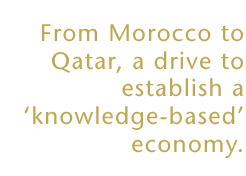 Nearly two and half years ago, in October 2007, another Arab ruler stood on a remote shore, in this case along the Red Sea coast, astride another small fishing village, the Saudi Arabian town of Thuwal, and laid the foundation stone for a similarly ambitious and monumental educational project.
Nearly two and half years ago, in October 2007, another Arab ruler stood on a remote shore, in this case along the Red Sea coast, astride another small fishing village, the Saudi Arabian town of Thuwal, and laid the foundation stone for a similarly ambitious and monumental educational project.
“Based on Islam’s eternal values, which urge us to seek knowledge and develop ourselves and our societies, and relying on God Almighty, we declare the establishment of King Abdullah University of Science and Technology, and hope it will be a source of knowledge and serve as a bridge between peoples and cultures,” proclaimed the Saudi ruler, King Abdullah ibn ‘Abd al-‘Aziz Al Sa‘ud. Though he did not promise to award the university’s resident scholars the weight in gold of their research papers, the new university’s endowment is among the largest in the world. That’s money on a scale that seems to match the king’s intention to make the University a new “House of Wisdom,” or as he put it: “A forum for science and research, and a beacon of knowledge for future generations.”
King Abdullah University of Science and Technology is a vast complex of high-tech research laboratories, classroom buildings, libraries and streets lined with homes and apartments overlooking the Red Sea, lying about an hour north of Jiddah. The graduate-level university, which opened last year to fanfare and fireworks on September 23, Saudi Arabia’s national day, is one of the newest, and perhaps the most spectacular, of a growing number of institutions of higher learning to open in the area, particularly in the Gulf region, in recent years. Many of them look abroad—especially to America—for their models. Though King Abdullah University officials point out that their institution is more international than American in its philosophy and structure, it is nonetheless part of a wider movement, stretching from Morocco to Qatar, that seeks not only to recapture past intellectual glory but also to establish new “knowledge-based” economies.
“The knowledge gap separating the Arab and Islamic nations from the advancement of contemporary global civilization is becoming deeper and wider,” remarked Abdallah S. Jum‘ah, former president and ceo of the Saudi Arabian Oil Company (Saudi Aramco), which was tasked with building the University in 2006. Speaking at the 2007 groundbreaking ceremony, Jum‘ah declared that “the fostering of a culture of scientific research and indigenous development capabilities is imperative. In this regard, kaust … represents a critical development to shrink the knowledge gap.”
Once, the West was behind in the knowledge gap Jum‘ah referred to, and once, Europeans came to the Middle East to study. But in recent centuries, and especially for much of the past 50 years, the flow of students has been largely in an East-to-West direction, with many Arabs from the Gulf and elsewhere traveling, most often to the us, for university educations. Yet the history of American educational institutions in the region dates back a further half century and more to schools that are now household names in the field of high-quality higher education in the Middle East—institutions like the American University of Beirut (aub) or the American University in Cairo (auc), which serve as good examples of how western-style education in the region developed.
 |
| corbis |
| The American University of Beirut, shown above in 1921, was among the early us-style institutions of higher education in the Middle East. Below: Today, its graduates live and work worldwide. |
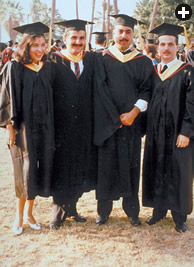 |
| aileen vincent barwood / sawdia |
Around the beginning of the last century, the higher-education system in the Middle East—especially the Gulf—was limited. Most girls received no education outside the home, while young men and boys were typically schooled by an imam (religious leader) who taught the memorization of the Qur’an, as well as the traditions (hadith) of the Prophet Muhammad. Those who showed promise might go on to learn Islamic jurisprudence (fiqh) at a madrassa (mosque school), or study in the famous universities at Cairo’s al-Azhar Mosque or the Kairouan Mosque in Tunisia. While such institutions produced knowledgeable clerics and scholars of Islamic law, they did not emphasize what are recognized today as the arts and sciences.
It was actually the French, not the Americans, who led the way among western educators in establishing schools in the Middle East, with missionaries opening facilities in Lebanon and Syria as early as the 1730’s. The French influence in Egypt stemmed in part from Napoleon’s occupation of the country at the turn of the 18th century, but also owed much to the country’s Ottoman-era ruler, Muhammad Ali (1769–1849), who was cared for as a child by the French owner of a tobacco shop. (Even as late as the 1950’s, after decades of British political control, there remained more French than English schools in Egypt.)
It was Ibrahim Pasha, Muhammad Ali’s son, who opened the doors for the first American Protestant missionary schools in Syria, where he was governor. By 1860, American missionaries ran more than 30 primary and secondary schools in Syria. In December 1866 in Beirut, they opened the doors of the Syrian Protestant College, which would later become the American University of Beirut.
Aub’s founder and first president, Daniel Bliss—an Amherst-educated Congregationalist from Vermont—believed that, while Arab students were exceptional at memorization, they needed strengthening in abstract thinking ability. As Robert Kaplan puts it in his book The Arabists, “The college’s success or failure could rest only on its ability to teach its students how to organize and interpret facts.”
This approach to education was one of many advances pioneered by the Syrian Protestant College and others in the region. Further innovations included schools for women (such as the Syrian Protestant College’s school of nursing, which opened in 1905) and admitting women alongside men, which the school—by then called aub—did in 1924. Egypt’s State University in Cairo followed suit four years later. Beirut’s Lebanese American University (lau) also traces its roots back to a Protestant missionary school for girls, the American School for Girls, founded in 1835.
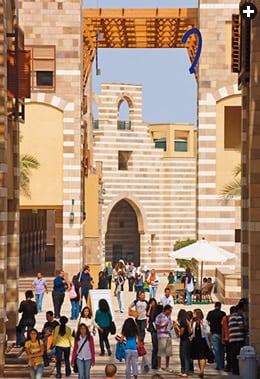 |
| b. o'kane / alamy |
| Founded in 1919, the American University in Cairo moved in 2008 to an expanded campus whose design pays homage to medieval Cairo. |
In Turkey, American Protestant missionaries had been establishing schools, initially for Christians, since the 1820’s. The jewel in their crown was Robert College, opened by Cyrus Hamlin of Maine and New York businessman Christopher Robert in 1863. It offered students, “without distinction of race or religion, a thorough education equal in all respects to that obtained at a first-class American college and based upon the same general principles,” according an early catalog. In 1890, it was joined by the American College for Girls. In 1971, these institutions were folded into the new Boğaziçi University, which encompasses the original Robert College campus.
Egypt’s own Protestant-founded academy, the American University in Cairo, or auc, opened in 1919. Established in a former palace in central Cairo, a couple of blocks east of the Nile, auc, like its counterparts elsewhere, attracted the sons and daughters of local aristocrats who regarded America’s presence in the Middle East as largely philanthropic.
Like aub’s Bliss and Robert College’s Hamlin, auc founder Charles R. Watson —another New Englander—understood that, to be accepted in the region, an American-run institution of higher learning needed to address local concerns. Thus auc established a teacher-training division, a rural extension service and, in 1921, one of the region’s earliest schools of “oriental studies.”
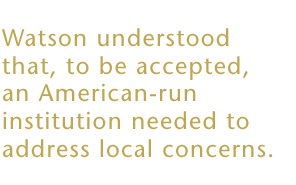 Meanwhile, farther east in the Gulf, the booming pearl industry gave rise around the turn of the 20th century to a mercantile class whose members desired, and could afford to build, systems of formal education among their tribesmen. (The oil industry would have a somewhat similar effect half a century or so later.) In Dubai and Sharjah in today’s United Arab Emirates (uae), and in Qatar, Bahrain and elsewhere, many of these early schools were run by Egyptians and Palestinians following Egyptian curricula, which included math and local geography as well as Arab and even European history.
Meanwhile, farther east in the Gulf, the booming pearl industry gave rise around the turn of the 20th century to a mercantile class whose members desired, and could afford to build, systems of formal education among their tribesmen. (The oil industry would have a somewhat similar effect half a century or so later.) In Dubai and Sharjah in today’s United Arab Emirates (uae), and in Qatar, Bahrain and elsewhere, many of these early schools were run by Egyptians and Palestinians following Egyptian curricula, which included math and local geography as well as Arab and even European history.
An example of such an early school can be found in Sharjah, along Sharjah Creek in the heart of the “Old City.” Hanging on the raffia-covered classroom walls of the charmingly restored Eslah School, established in 1935 by Shaykh Mohammed bin Ali Al Mahmoud, are pictures of some of the forward-thinking schoolmasters of the time: Dubai-educated Hashem bin al-Sayed Reda al-Hashemy, who established Sharjah’s first printing press, and Abdullah bin Saleh al-Motawaa, among whose claims to fame was his endorsement of education for girls.
The collapse of the pearling industry in the mid- to late 1930’s—a ripple effect of the Great Depression in the us and Europe, worsened by competition from Japanese cultured pearls—left the Gulf’s economy languishing and caused many schools to close. Later, the unprecedented influx of oil wealth during the 1950’s and 1960’s forever changed Gulf economies, as well as Gulf society. Along with this new wealth came centralized governments—after the departure of the British from the states with which they had treaties—which included ministries of education. They began establishing today’s schools, from kindergartens right on through universities.
It was also around this time that nations in the region began looking to the West for higher education. Money from oil revenues provided generous scholarships to send students overseas, particularly to the us, where the reputations of schools such as Stanford, Princeton, Texas A&M, Georgetown and others—with their degrees in business, engineering and international relations—attracted a generation of Arab and Muslim students. They came to take advantage of the best that American higher education had to offer, and they returned home to take up prominent positions in government and industry—especially the petroleum industry. In 1979, Iran—on the eve of its revolution—led the Middle East in the number of students abroad, with some 50,000 studying in the us, according to a 2004 report by World Education Services. The mid 1970’s through the early 1980’s, the report notes, “marked the peak of Middle Eastern student enrollments in the us.”
Political turmoil and strained us-Arab relations in the decades that followed led to declines in the numbers of Middle Eastern students seeking American educations. Then, for several years after 9/11, it became increasingly difficult for Muslims and Arabs to obtain student visas at all—at one time a fairly straightforward process. A 2004 survey conducted by the Institute of International Education reported that 59 percent of Arab and Muslim students who wished to go to school in the us gave up their plans because of the new, lengthy background checks and long waiting periods.
Although Middle Eastern students by then had any number of local, usually government-run universities from which to chose, many still perceived a western-style education as a desirable ticket to success. And in recent years, as visa delays have been reduced and background checks speeded up, the Saudi government in particular has initiated a generous scholarship program for study abroad. Saudi enrollment in us universities in 2008-2009 increased by 28 percent over the previous academic year, reaching 12,661.
It was during the last 10 to 15 years that the model of the American-style university in the Middle East began to enjoy a renaissance, thanks primarily to the long-range vision of local leaders.
Shaykh Sultan bin Mohammed Al-Qasimi is one such leader. Ruler of Sharjah for 37 years and a member of the uae’s Supreme Council, the 71-year-old Shaykh Sultan is a passionate scholar and historian—a modern-day al-Ma’mun—and the sort of fellow who can happily lose himself for hours leafing through a copy of Claudius Ptolemy’s second-century treatise on geography. Sharjah’s onetime minister of education, he was pressed into service as the emirate’s ruler after the assassination of his elder brother in 1972. But education remains near and dear to his heart.
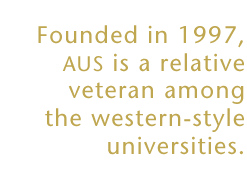 “If you want to see him get excited, ask him about history, about learning,” says Malcolm Richards, dean of the School of Business and Management at the American University of Sharjah (aus), a 125-hectare (313-acre) campus of palm trees, tranquil pools and monumental domed buildings a few kilometers east of downtown Sharjah. Aus was founded in 1997 and is thus a relative veteran among the new western-style universities in the region. It is an impressive example of what happens when you combine powerful financial resources ($135 million out of the shaykh’s pocket alone) and the vision of a man who knows precisely what he wants in an institution of higher learning, from the floor tiles right up to the rooftops.
“If you want to see him get excited, ask him about history, about learning,” says Malcolm Richards, dean of the School of Business and Management at the American University of Sharjah (aus), a 125-hectare (313-acre) campus of palm trees, tranquil pools and monumental domed buildings a few kilometers east of downtown Sharjah. Aus was founded in 1997 and is thus a relative veteran among the new western-style universities in the region. It is an impressive example of what happens when you combine powerful financial resources ($135 million out of the shaykh’s pocket alone) and the vision of a man who knows precisely what he wants in an institution of higher learning, from the floor tiles right up to the rooftops.
“When they were building the library, the shaykh looked at its dome and thought it conflicted with the dome on the Main Building, so he said, ‘Take it down,’” recalls Richards. “He didn’t like the second one either, so he said, ‘Take it down’ again. Then they finally got it right.”
 |
| Art Clark |
| On a spring afternoon, students relax on the front steps of the American University of Sharjah (aus) in the United Arab Emirates (uae). Aus enrolls some 5200 undergraduates, about 20 percent from the uae, followed by contingents from Jordan, Egypt and Palestine. After graduation, many stick around: Some three-fourths of its more than 5000 alumni live in the uae. |
While the stunning lemony-white exteriors and vaguely Mughal domes, columns and arches may well inspire, it’s what goes on in the classrooms of aus and other such institutions across the Middle East that is turning the region’s educational system on its ear.
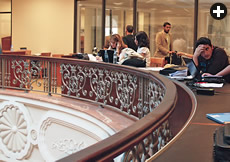 |
| Art Clark |
| Students crack books and laptops in aus's library. |
“There has been a disillusionment, unfortunately, with the capabilities of the national universities in the Gulf and Middle East,” says aus chancellor Peter Heath. “Whether new universities or branch campuses, it’s really based on parents’ dissatisfaction with the status quo.”
Heath’s assessment is not mere boosterism for his own institution. Prior to coming to Sharjah last year, he served for 10 years as the provost of aub, many of those years during a time when the university was rebuilding and restabilizing itself in the wake of the 2006 Lebanon war. Thus he has been surveying this landscape for some time from the perspective of an insider who has observed, and contributed to, the growth of western-style higher education in the Middle East.
It is, in fact, a fairly broad landscape, with choices ranging from what are little more than glorified tech schools to actual branch campuses of some of America’s leading universities. Whatever their pedigrees, common elements among most of these models include classes taught in English, a predominantly American faculty and an emphasis on critical thinking and problem-solving.
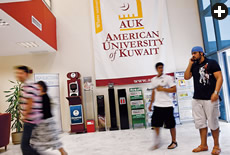 |
| bryan denton / corbis |
| Established in 2003, the American University of Kuwait (auk) partnered with Dartmouth College in New Hampshire to develop a liberal-arts program. It has also mounted local initiatives, such as the Arabian Heritage Project, which focuses on the traditional cultures of the Arabian Peninsula. |
With an eye toward a future in which economies are not buoyed as much by oil and natural gas as they are today, the founders of these institutions, such as Sharjah’s Shaykh Sultan, Saudi Arabia’s King Abdullah and Qatar’s Shaykhah Mozah bint Nasser Al Missned, have geared curricula toward the scientific and the technical, with emphasis on research and development. Thus, while poetry, history and the like are on offer in most of the institutions, as they are at any liberal-arts school, the emphases here are on schools of business, medicine, engineering and design.
“I came here to study architecture and design, because I feel these disciplines will better prepare me for life and a career,” says Farah Istieteih, an aus freshman from Jordan, who sat with a sketchpad in her lap and a thumb extended, for perspective, toward an elaborately decorated doorway of the auditorium. Her classmate, Rawand al-Muhtaseb, from Syria, was equally resolute and even more single-minded.
“I am studying mass communication and want to go on from here to graduate studies at Northwestern, then into public relations and advertising. I have a definite plan,” says the second-semester freshman, with a confident, mediagenic smile.
Al-Muhtaseb is one of about 5000 students at aus, an enrollment that is on target for the school’s growth and capacity. Yet even though “the popularity of American-style education in Arab society is at an all-time high,” according to a 2007 study by the Washington Institute for Near East Policy, the challenges associated with such ventures are as real today as they were in Daniel Bliss’s day: how to teach critical thinking; how to attract and retain top expatriate faculty; how to address the sensitive issues around co-education; how to teach top-quality course material in English to students for whom English is a second language; and how to adapt western concepts to a Middle Eastern classroom.
“From a business-school perspective, the fundamentals of things like human-resource management, accounting principles, basic marketing—those don’t change that much,” said aus’s Richards. “But then there are things like shariah [Islamic] law and Islamic finance, which are very important here, that we need to prepare our students for.”
Such curricular integration is critical, according to aus’s English Department head, Fatima Badry. In a survey she conducted in 2008 on the globalization of higher education in the Gulf, she was alarmed to find that western-style universities in the uae offered little that might fall under the heading “local studies.”
“I found that less than a quarter of the courses had anything to do with local culture, history, society,” says Badry. As a linguist, she also fears the loss of Arabic on college campuses in the Gulf and elsewhere in the Arab world where western-style higher education is on the rise.
“There is a middle road,” she says, pointing out that while college and university administrators from France to South Africa to Turkey recognize that English provides access to worldwide, Internet-based knowledge these days, local language and culture need not be sacrificed.
“It doesn’t have to be either-or,” she says. “It is a false dilemma that either we go with English to modernize our education, or we stay with Arabic and we are considered traditional and backward-looking. All the studies show that you can be bilingual and still have a successful educational model.”
Aus’s mission from the beginning has been to provide “a liberal-arts education, based on the American model, grounded in Arab culture,” says Badry. She questions whether the institution is living up to the latter part of that statement, yet wryly acknowledges that its first part is what guarantees her the academic freedom to voice such a concern in the first place.
The Starbucks at the student center at Education City in Doha features tribal carpets, cushions and a full Bedouin tent. That may not be quite the kind of cultural balance Badry has in mind, yet it’s as quintessential a picture of East meeting West as you will find here in Qatar, a thumb-shaped nation jutting into the Gulf a few hundred kilometers up the coast from Sharjah. Female students in inky black abayas and young men in crisp white thawbs sit cross-legged beneath the folds of the tent, engaged in typical graduate-school chat over foamy grande lattes and the pages of science and engineering textbooks the size of Manhattan telephone directories.
Outside, in the glaring sun and soaring temperatures, ideas are literally sprouting. Bright yellow, shoulder-high letters spelling out words such as “Innovate” and “Think,” in English and Arabic, erupt from the emerald-green lawns of the Qatar Foundation’s 15-year-old Education City, a 1000-hectare (2500-acre) conglomeration of high-tech buildings and branch campuses of well-regarded American universities, including Cornell, Carnegie Mellon, Northwestern, Georgetown, Texas A&M and Virginia Commonwealth. The inspiration behind the big yellow words—and the daring enterprise itself—is that of Qatar’s dynamic shaykhah and foundation chairperson Mozah bint Nasser Al Missned. Employing a different model from aus, Shaykhah Mozah attracted these prestigious American institutions by employing incentives that no dean of admissions or chief financial officer could resist.
 |
| Art Clark |
| An ovoid lecture hall, above, stands at the center of Weill Cornell Medical College in Qatar, one of the six universities whose branch campuses offer full-fledged us degrees at Education City. |
“The Qatar Foundation told us, ‘Whatever you need, we’ll get for you,’” says Mark H. Weichold, dean of Texas A&M at Qatar. “Because we’re a Texas state school, we can’t spend state money over here, so the foundation has taken care of everything. It’s what made it possible for us to even think about establishing a campus here in the Middle East.”
While A&M—long an alma mater to many Arab students—already had something of a global presence, the Qatar Foundation invitation was strongly appealing from both academic and financial perspectives.
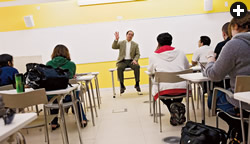 |
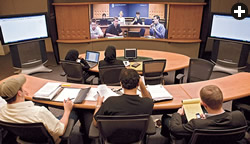 |
| bryan denton / corbis (2) |
| While some classrooms are traditional (top), others, such as the one shown above at Georgetown University's Education City branch, feature live videoconferencing. |
“Doha is the place to be in terms of oil and liquefied natural gas [lng] production,” says Weichold. “It’s not too hard to connect the dots between what Qatar has to offer and what our students will be exposed to in terms of state-of-the-art facilities and access to systems and technology that are unavailable in Texas.”
A brand-new petroleum and petrochemical safety research college, in partnership with Texas A&M, British Petroleum and Qatar Petroleum, in the industrial port city of Ras Laffan, about an hour’s drive northeast of Doha, is a good example.“Ph.D. students can conduct research there on the dynamics of lng fires, fire engineering, fire-fighting and safety methods,” says Weichold. “They can study oil spills in the ocean and lng emergencies under controlled conditions.”
On the flip side, Education City offers Middle Eastern and foreign-national students something they can’t otherwise obtain locally—an American diploma from an American university, without having to travel to America.
“The institutions at Education City are not ‘American-style,’ or ‘drawn from’ or ‘inspired by’ universities in the United States. They are us universities,” says Chuck Thorpe, Carnegie Mellon Qatar’s dean. “We are not like Carnegie Mellon: We are Carnegie Mellon, and when you graduate from here, you do so with a Carnegie Mellon degree in your hand.”
It is the prestige associated with such a degree that the Qatar Foundation is banking on to attract students. Other Gulf states using the same strategy include Dubai, with its International Academic City, where Michigan State University stands out among a bevy of smaller international institutions, and Abu Dhabi, where New York University established a branch campus on the emirate’s $27-billion Saadiyat Island, not far from a branch of another distinguished New York institution, the Guggenheim Museum.
The allure of this model is that, like a franchise, it has name recognition and systems in place almost as soon as the ceremonial ribbons are cut and the lecture-hall doors open.
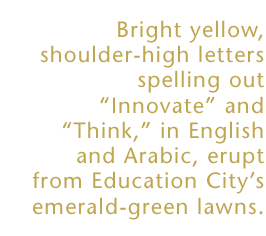 “They carry the policies and procedures and admission requirements of the mother institution and benefit from its reputation,” according to Shafeeq Ghabra, co-author of the Washington Institute report. In addition, Ghabra observes, “These universities do not face the start-up problems most new private universities and colleges in the Arab world do.” Those start-up issues include the lengthy process of accreditation. Because they are American institutions operating overseas at the invitation of foreign governments—almost like embassies—universities at Education City get right down to the business of educating students, conducting research and helping their host governments achieve a critical goal for future survival: the transformation of commodity-based economies into knowledge-based ones.
“They carry the policies and procedures and admission requirements of the mother institution and benefit from its reputation,” according to Shafeeq Ghabra, co-author of the Washington Institute report. In addition, Ghabra observes, “These universities do not face the start-up problems most new private universities and colleges in the Arab world do.” Those start-up issues include the lengthy process of accreditation. Because they are American institutions operating overseas at the invitation of foreign governments—almost like embassies—universities at Education City get right down to the business of educating students, conducting research and helping their host governments achieve a critical goal for future survival: the transformation of commodity-based economies into knowledge-based ones.
“Doha in 2009 is a lot like Pittsburgh in 1909,” observes Thorpe. “There you had the richest man in the world, Andrew Carnegie, running the steel business, and a population of immigrant workers from all over, working in the industry. But Carnegie realized the future was in aluminum and had the vision to diversify. We’re doing the same here by training our graduates to explore new ideas in computer science, information systems technology and robotics.”
Like Texas A&M, Carnegie Mellon tailors its curricula and research to meet specific regional needs, such as establishing (in cooperation with ibm, A&M and Qatar University) one of the Middle East’s first “cloud-computing” initiatives, an Internet-based system that will deliver hosted services—applications, research and seismic modeling for oil and natural gas exploration—to local businesses and industries. Meanwhile, in its robotics labs, Carnegie Mellon researchers ponder uniquely Middle Eastern solutions to uniquely Middle Eastern challenges in the field of artificial intelligence, such as the nature of human-robot interactions in Arab social and cultural settings. One result: “Hala” (whose name means “welcome” in Arabic), a computer-robot receptionist that can distinguish the gender and clothing style of an approaching person (traditional Gulf or western) and respond accordingly in either Arabic or English.
Yet with local solutions come local dilemmas, not the least of which are language problems of the sort that aus’s Badry noted.
“I’ve had managers at Qatar Petroleum tell me that the computer-science students we send them are excellent, but that their Arabic is not good enough,” says Thorpe.
Then there are cultural challenges that go beyond even the delicacy of coeducation—challenges that speak to the heart of a liberal-arts education.
“For example: How do you teach freedom of speech,” asks Richard Roth, dean of the journalism program at Northwestern University in Qatar, “in a part of the world where it is not protected?” Answering his own question, he says, “The same way we teach it in the States.”
This means his students get out into the field rather than relying on press releases, and they decline gifts from sources in exchange for favorable coverage—a custom which, in many news organizations in the Arab world, might be considered acceptable. Yet at the same time, Roth observes, local traditions and sentiments can enhance and broaden American journalism-school curricula.
“We teach American-style journalism, but we’ve also had success tapping into the Bedouin style of storytelling, which is linear and direct, but colorful,” he says. “Also, a lot of American journalism-school students want to go into entertainment reporting. Here, the students are much more passionate about politics.”
Plans for Northwestern’s journalism school in Qatar include four large state-of-the-art broadcast studios and the world’s largest media wall. But the bigger and more magnificent the facilities, the more they seem to dwarf the student body on a campus that seems eerily empty: Enrollment at Northwestern is a mere 71 students, while most other schools in Education City hover between 100 and 250. Texas A&M is the exception, with 390—a figure that is on target for the school’s enrollment.
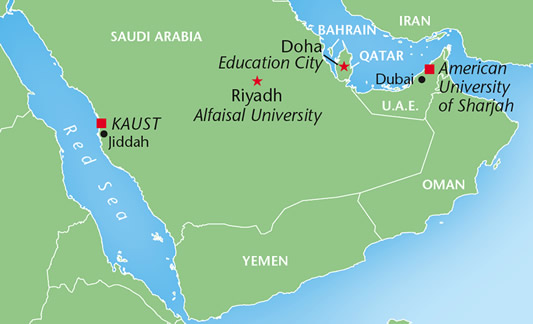 |
And such numbers can make all the difference. Last year’s financial meltdown in Dubai left Michigan State University and the Rochester Institute of Technology struggling to attract qualified students not only from among uae citizens, but also from a shrinking pool of expatriate families, many of whom left the country in the economic crisis. Earlier in the year, George Mason University (gmu) closed its Ras al-Khaimah campus in the uae without graduating a single student, due in part to low enrollment and severe budget cuts. The campus has since been given a chance at a new life by the newly created American University of Ras al-Khaimah. A sentence in a May 25, 2009 story in the English-language Abu Dhabi daily The National summarized the new school’s strategy: “The new government college … will have lower admission requirements and fees in the hope of attracting more students.”
Qatar’s Education City is in a different situation, says Thorpe, because it is foundation-supported. The gmu campus, he points out, was corporate-sponsored, as was Michigan State, which made them more vulnerable to market economics. A computer scientist by training and diplomat by nature, Thorpe remains focused and more than optimistic about Education City and enrollment numbers, which he said are currently capped at 100 at Carnegie Mellon to maintain slow, steady growth.
“At Carnegie Mellon, we are problem solvers, and we believe in bringing Pittsburgh to the problem,” he said. “But there are five other institutions here as well, and when you bring together people with different areas of expertise and different backgrounds and ideas, it is very powerful.”
If Education City is a foundation-financed collection of powerhouse institutions and aus is a visionary’s version of an American university, then Saudi Arabia’s two-year-old Alfaisal University in Riyadh is something of a hybrid. Supported by the King Faisal Foundation, the university is nonprofit but private rather than state-funded.
Instead of welcoming branches of brand-name American universities, Alfaisal University has called on them to form partnerships to help the Saudi university’s administration develop its own infrastructure and curricula. Thus Alfaisal’s College of Medicine has collaborated with Harvard Medical International (essentially a consultancy arm of the Harvard Medical School) to design programs and facilities and recruit faculty, while the engineering school makes use of free course material from the Massachusetts Institute of Technology through the Cambridge school’s Web-based OpenCourseWare initiative.
 |
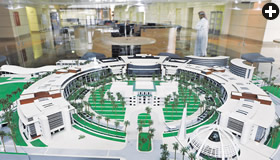 |
| Dick Doughty (2) |
| Top: In Riyadh, Saudi Arabia, students in Alfaisal University's University Preparatory Program receive hands-on lab instruction from biology instructor Drew Clippard, left. Above: A model shows Alfaisal's four colleges, some still under construction, as well as its mosque (lower right), all circling the palace of Saudi Arabia's late King Faisal ibn 'Abd al-'Aziz. |
This strategy has become increasingly common in recent years in Saudi Arabia and the larger region. Effat University, a women’s institution in Jiddah, has partnered with Swarthmore, Duke University’s Pratt School of Engineering, Georgetown’s School of Business, Mount Holyoke and others. In Kuwait, the American College of the Middle East has signed agreements with Purdue to help develop programs, while that nation’s first private college, the Gulf University of Science and Technology, opened in 2002 under an agreement with the University of Missouri at St. Louis.
Despite such arrangements, however, and though its classes are taught in English and modeled on American-style curricula, Alfaisal remains distinctively Saudi. The architectural centerpiece of its campus (still under construction) is the restored palace of the late Saudi king Faisal ibn ‘Abd al-‘Aziz, around which the colleges of business, medicine, engineering, science and general studies are circled like clan leaders sitting around a tribal shaykh. Meanwhile, Alfaisal’s all-dome mosque, wrapped for shade by concentric louvers, sits like an upside-down bowl whose smooth arcs play off the sharp taper of its needle minaret. One of the first buildings erected on the new campus, the mosque does not dominate the facility, but it offers a focal point that counterbalances the restored palace.
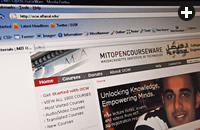 |
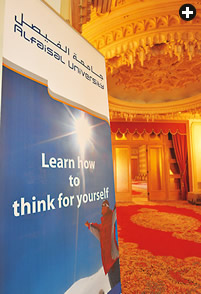 |
| Dick Doughty (2) |
| Top: Alfaisal taps into supplements on-line, such as the Massachusetts Institute of Technology's free OpenCourseWare program. Above: In the former royal palace, a sign
spells out a clear message to students. |
“We say we are western-style, yet are still a Saudi university,” says Maher A. Alodan, dean of the engineering school and vice president for research and graduate studies. Like many educated men of his and his father’s generation, Alodan, in his 40’s, earned a doctoral degree in the us. His Ph.D. diploma in chemical engineering from the University of Minnesota occupies a conspicuous place on the wall behind his desk. But the time has come, he says, for Saudis and other students in the region to look homeward to solve the problems at home. “We want to educate students to conduct research here, and produce graduates who have the skill and the knowledge to contribute to the economy,” he says.
Alodan’s counterpart at Alfaisal’s college of medicine, Dean Khaled Mana’a Alkattan, echoes this sentiment, with a pointed observation.
“If you look at the medical community in Saudi Arabia today, only 30 percent of the doctors are Saudi. The rest are expatriates. We need to address that,” he says.
By focusing on its specific disciplines, Alkattan said, Alfaisal is readying a new generation for entrepreneurship, finance, business management, genetics and biotechnology on both local and global levels. So far, the school has done an effective job of marketing itself to its target audience—students not just from Saudi Arabia, but from throughout the Muslim world and even the Arab diasporas in the West.
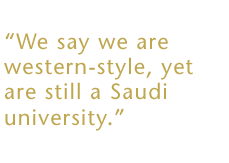 “I did a semester at McMaster University in Canada, but found that the student body was way too big. Plus, I missed my family,” says Mohammed Khusheim, a Saudi who is now studying medicine. Aside from a smaller, more culturally familiar student body, Khusheim appreciates the school’s approach to education.
“I did a semester at McMaster University in Canada, but found that the student body was way too big. Plus, I missed my family,” says Mohammed Khusheim, a Saudi who is now studying medicine. Aside from a smaller, more culturally familiar student body, Khusheim appreciates the school’s approach to education.
“It’s a combination of problem-based learning and traditional lectures. I think it works well,” he says.
But not every incoming freshman is prepared for this type of curriculum. In some cases, a certain amount of ramping up is required.
“Not every high school can expose its students to such things as hands-on lab experiments,” says Sudanese student Ayman Mohamed.
Hence, Alfaisal’s University Preparatory Program (upp) has been designed to walk students who need the help through the basics of lab techniques, scientific research and critical thinking in medicine, engineering and business for a year before they start their degree programs.
“Such training is necessary for a student population of varied backgrounds,” says Ala Al Bakri, Alfaisal’s vice provost for accreditation and quality assurance. “It’s not a homogeneous group. We have people from the general education Saudi system, people from the Jordanian system, from ib [International Baccalaureate] programs—you name it.” Upp ensures that everyone starts off at the same level.
Alfaisal administrators have high aspirations for the school’s graduates and for what the institution can offer both the kingdom and the region. “The vision and mission of the school is to help provide future leaders for Saudi Arabia and the region,” said Al Bakri, with a determined edge to his voice that is characteristic of many educators in the region who have taken on no less a task than reshaping the higher education systems in their own countries, using a road map from another.
Then there is the institution on Saudi Arabia’s Red Sea coast that may be rewriting the road maps of higher education altogether: King Abdullah University of Science and Technology.
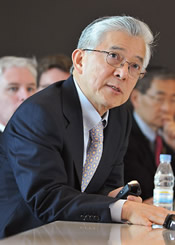 |
| Dick Doughty |
| King Abdullah University is organized to tackle the really big problems of water, energy, food and environment, explains President Choon Fong Shih, who holds a doctorate from Harvard. |
It is difficult for a visitor to maintain perspective at the University. It is anomalous, yet familiar: An Oz-like complex set on the edge of the desert, overlooking a lonely stretch of Red Sea beachfront, yet architecturally similar to any number of Fortune-500 company R&D centers. It’s imposing and polished, yet unfinished: Construction dust competes with blowing sand, while palm-tree saplings still wrapped in burlap line the main entranceway like beach umbrellas waiting for summer. It’s a degree-granting university with many western-trained professors and researchers that has nonetheless rejected the traditional western organizational model in favor of a pragmatic, interdisciplinary approach focused on “sustainable prosperity” and the attendant issues of energy, food, water, environment and computer technology. Such an approach, faculty and administrators say, is breaking down walls that have compartmentalized universities since the Middle Ages.
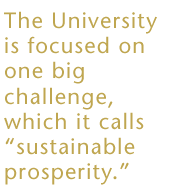 The University “was built to do interdisciplinary research and to solve new problems,” says Mohamed Samaha, a 30-year Saudi Aramco veteran who is now the University’s senior vice president of research and economic development. He and other Saudi Aramco colleagues, past and present, including projects-and-planning expert Nadhmi Al-Nasr—now interim vice president of administration and finance—were called on in mid-2006 to build the institution from the sand up. Sitting in an expansive office overlooking the University’s iconic Breakwater Beacon, which rises from the edge of the campus’s artificial lagoon, Samaha shrugged off the scale of such a task with a self-effacing chuckle.
The University “was built to do interdisciplinary research and to solve new problems,” says Mohamed Samaha, a 30-year Saudi Aramco veteran who is now the University’s senior vice president of research and economic development. He and other Saudi Aramco colleagues, past and present, including projects-and-planning expert Nadhmi Al-Nasr—now interim vice president of administration and finance—were called on in mid-2006 to build the institution from the sand up. Sitting in an expansive office overlooking the University’s iconic Breakwater Beacon, which rises from the edge of the campus’s artificial lagoon, Samaha shrugged off the scale of such a task with a self-effacing chuckle.
“Aramco is known for building major projects. That is what we do,” he says.
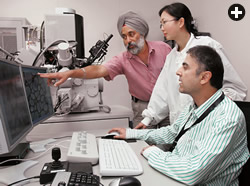 |
| j. b. picoulet / pcp / King Abdullah University of Science and Technology |
| |
 |
| Dick Doughty |
| Tools to tackle the problems Shih describes include “Shaheen,” above, centerpiece of the Supercomputing Research Center, established in partnership with IBM. Top: Researchers and faculty from around the world give King Abdullah University a cosmopolitan feel. |
Still, building the University was a task unlike any other that Saudi Aramco had faced, according to Al-Nasr, who spearheaded the project. It started, he recalls, with a phone call from Minister of Petroleum and Mineral Resources Ali I. Al-Naimi, telling Saudi Aramco that King Abdullah wanted the company to undertake construction. Al-Nasr quickly assembled a team, discussed building sizes and locations—and then learned that, in addition to building the physical university, the king also expected Saudi Aramco
to design and start up
the institution itself—and operate it for the first
five years.
The aim was the creation of a research institute—“one of the best in the world”—to help lead the kingdom’s transition into a knowledge-based economy using the world’s best talent. And the king wanted it open in three years.
To do that, Al-Nasr’s team, often accompanied by Al-Naimi, reached out to the world’s top universities and academic advisors. “We went around the world—the us, Europe and Asia. In every place we visited, without one exception, they initially met us with skepticism that a job so big could be accomplished so quickly. They said, ‘Either you’re out of your mind or you don’t really know what you’re up to,’” says Al-Nasr.
But as the team continued to discuss the project, its goals and its support, university leaders came on board, and a number of them formed an advisory group that met regularly with Al-Naimi to hear ideas and offer their own. “When they listened to us, they didn’t listen to dreamers—although we were dreaming,” says Al-Nasr. “They listened to people who were very realistic and who wanted to learn.”
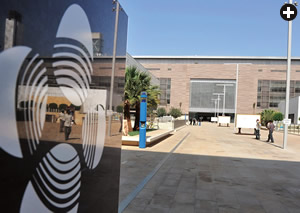 |
 |
| Dick Doughty (2) |
| Top: Built by Saudi Aramco in three years on the site of a former fishing village, the university devised a logo that reflects its goal of becoming a world research hub. The library, above, offers on-line resources alongside traditional book stacks. |
Even before ground was actually broken in the fall of 2007, the University had been established and was signing research agreements and offering scholarships to prospective students—many of whom were still a year or so away from receiving their bachelor’s degrees—and recruiting professors and administrators.
The fruits of those labors are what can be seen today.
For its building blocks, the University utilized many of the same elements as other western-style institutions in the region: top-notch facilities and faculty, partnerships with educational and corporate entities worldwide, and a focus on research and development.
It also faces many of the same challenges. Enrollment at the school is currently about 400, and it plans to raise that number gradually to about 2000. Among the initial crop of students, many are working on master’s degrees rather than the more desirable Ph.D.’s. Saudis make up some 15 percent of the student body, and the rest are from around the globe, with China, the us and Mexico heavily represented. Instruction is in English and, while faculty members hail from 40 countries, the majority are American.
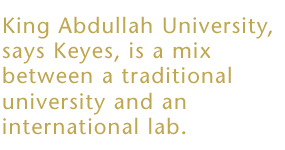 This all lends a tangible air of cosmopolitan collegiality to the campus, from its Singapore-born, Harvard-educated mechanical-engineer president, Choon Fong Shih, to its Australian info-tech crews, to the curries on offer in the cafeteria alongside Texas chili. Yet what genuinely inspires comparison to the famed Abbasid House of Wisdom is the sheer novelty and ingenuity of the place—what you get when you give good planners a noble goal and generous funding, and tell them to go do their best.
This all lends a tangible air of cosmopolitan collegiality to the campus, from its Singapore-born, Harvard-educated mechanical-engineer president, Choon Fong Shih, to its Australian info-tech crews, to the curries on offer in the cafeteria alongside Texas chili. Yet what genuinely inspires comparison to the famed Abbasid House of Wisdom is the sheer novelty and ingenuity of the place—what you get when you give good planners a noble goal and generous funding, and tell them to go do their best.
“The credit for the intellectual design largely goes back to Frank Press, who runs a group called the Washington Advisory Group, basically a bunch of retired university presidents, which kaust consulted on how to create this institution,” explains David Keyes, dean and professor of applied mathematics and computer sciences at King Abdullah University. Press, an 86-year-old geologist, is a former chairman of the us National Academy of Science and served as President Jimmy Carter’s science advisor. While Saudi Aramco itself ran the construction job, Press and his outfit put King Abdullah University in touch with university officials worldwide who advised on filling the buildings with its human resources and outfitting its labs with state-of-the-art equipment. (This includes one of the world’s fastest supercomputers, the world’s most powerful nuclear magnetic resonance spectrometer and a six-sided virtual-reality visualization room that turns raw data into manipulable 3-D images.)
 |
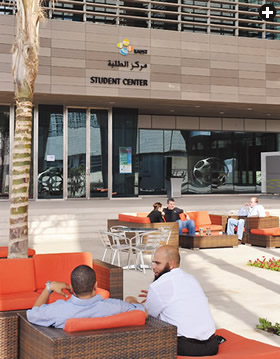 |
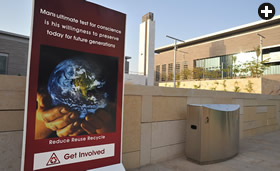 |
| Dick Doughty (3) |
| Surrounding the University is a self-contained community to support the families of researchers, a group planned to grow to number more than 2000. Today the community includes a free bus system connecting homes with the modest commercial district (top, middle) as well as schools through grade 12 and a student center. Left: All waste bins separate recyclables, and a sign in the center of the campus summarizes the University's philosophy of "sustainable prosperity." |
But beyond filling offices and labs, the aim was “creating a new kind of university, outside of the mold,” says Keyes. Instead of separate disciplines, faculty are clustered into four interdisciplinary “divisions”—energy and environmental resources, biosciences and bioengineering, materials science and engineering, and applied mathematics and computational science. They offer degrees in nine fields, a number that may grow to 20 in the next five years. The disciplines are organized under “centers” rather than departments—a significant departure from the us university model.
“Think about the typical American research university,” Keyes explains. “It evolved from a college. Colleges have accredited majors. Everything is pipelined through disciplines. A national lab is very different. It’s given a mandate—to create a more fuel-efficient vehicle, or put a man on the moon, or develop a transportation network. Those people don’t reward how many papers you publish in scientific journals. They reward whether you can put together a team and solve a problem.” King Abdullah University, he says, “is a mix of those two philosophies.”
Thus a computer scientist and mathematician like Keyes can pull together data mined by University researchers in the genomics and nanobiology labs and feed them into a computer to produce a visualization of a protein’s mechanics. Gary Amy, director of the water desalination and reuse center, can work with, and draw on the expertise of, scientists from the Woods Hole Oceanographic Institute, one of the University’s 42 academic partners, with which it is developing its own Center for Marine and Oceanic Research to research conservation and exploration of the Red Sea, still a largely unexplored body of water. (Just over half of the 3600-hectare [8900-acre] “campus” is water: a protected Red Sea sanctuary.) Other partners include the Institut Français du Petrole, the Indian Institute of Technology in Mumbai, the National University of
Singapore and auc.
“We have this incredible source of water here that is undrinkable,” says Amy. “Some desalination processes put the extracted salts back in the water, but that causes an imbalance which can affect coral reefs. We’re looking to develop a greener method.”

Innovation, says Samaha, is what King Abdullah University is all about. Less than a year old, it has already developed 18 new technologies in desalination, nanotechnology, bioremediation and solar energy, he says. “This is an unusually high number in a short period of time.”
But patent applications are only a part of the bigger picture that the University is attempting to draw.
“We have very good schools in the region, built on the American model—auc, aus and others. They are excellent schools. But what we lack here in the region is a graduate-level research ecosystem—an institution dedicated solely to research that is truly interdisciplinary,”
says Samaha.
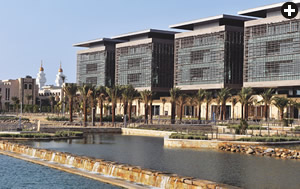 |
 |
| Dick Doughty (2) |
| Top and above: Buildings for the University's four "divisions" face a palm-lined lagoon; from the library, students enjoy a view of the Breakwater Beacon and the Red Sea beyond. |
To hear Samaha tell it, it’s an ambition that King Abdullah thinks of every day. “The king truly wants this to be a new House of Wisdom,” he says. “It is his dream.”
The legacies of the Abbasid House of Wisdom remain with us today, 12 centuries later: chemistry, algebra, engineering, optics, medicine and more. There isn’t a discipline in the natural or applied sciences that hasn’t been influenced, to one degree or another, by the men whom al-Ma’mun gathered in Baghdad more than a millennium ago.
But the future is what concerns the new generation of scholars and researchers who are coming together, from across the Arab world and beyond, to take advantage of the best of what the West and the East together have to offer. Perhaps Caliph al-Mansur would smile if he could see what is happening in this latest round of educational endeavors, for the dream it represents is much the same as his own. Felix Lao, a computer-science student at from Hong Kong, put it simply: “I love the vision of the king: to group different people from around the world here—to discover, solve problems and think about our future.”
 |
Writer Tom Verde (writah@gmail.com) holds a master’s in Islamic studies and Christian–Muslim relations from Hartford Seminary and teaches theology, philosophy and ethics at King’s Academy, a college-prep boarding school in Jordan. King’s Academy, he observes, “struggles with many of the same challenges as the schools in this article, of which the deepest is how to successfully merge what works for Jordan with what works for America—where many of the students will send the college applications they’ll soon be filling out.” |